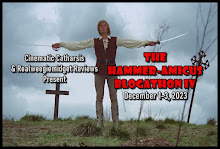
by Matthew Coniam
.
Time has been reasonably kind to The Stranger Came Home since its release in 1954: what seemed at the time to be just another middling British support thriller has gained something from its association with the later Hammer films.
With a few more - or more bizarre - plot twists it could almost play as the anticipatory cousin of the black and white psycho thrillers Jimmy Sangster wrote for the company in the sixties, beginning with Taste of Fear in 1961. Likewise the presence of Hollywood leading lady Paulette Goddard at the top of the cast - in truth nothing more than the latest in the ongoing practice of securing the services of a fading Hollywood name to ease US distribution through Robert Lippert - gives it a touch of class, and seems to bring future echoes of The Nanny, Fanatic and The Witches.
And, though it finally fails to follow through on it, the film does have a slightly more sinister feel to it than the average crime programmer, and benefits from a rather creepy lead performance from William Sylvester, a good actor and later star of Devil Doll (1964) and Devils of Darkness (1965).
Pleasing, too, to see the Hammer team in early formation: Sangster (as production manager), Fisher directing, Carreras Jr writing and producing, Phil Leakey (getting a chance to do a nasty scar!) in the make-up chair, and Molly Arbuthnot and Len Harris on board as well.
.
 The plot, sadly, is not bad but simply not surprising enough to stand comparison with the later Hammer thrillers. It has a very intriguing premise - man believed dead returns home after three years to unmask his would-be murderer - and the development is no less than satisfactory, but there are no shocks in the revelation: the guilty party could be any one of the main suspects - and is. And that's that. A last-minute surprise could have made a perfectly decent little thriller into a major sleeper. (And Paulette is rather dowdily photographed and costumed throughout the movie, never sporting anything even resembling the hairdos and costumes seen in either of the posters reproduced here, bearing the film's American release title.)
The plot, sadly, is not bad but simply not surprising enough to stand comparison with the later Hammer thrillers. It has a very intriguing premise - man believed dead returns home after three years to unmask his would-be murderer - and the development is no less than satisfactory, but there are no shocks in the revelation: the guilty party could be any one of the main suspects - and is. And that's that. A last-minute surprise could have made a perfectly decent little thriller into a major sleeper. (And Paulette is rather dowdily photographed and costumed throughout the movie, never sporting anything even resembling the hairdos and costumes seen in either of the posters reproduced here, bearing the film's American release title.)But what does make the film of considerable interest to the Hammer afficionado is the extensive photography in and around Down House (doubling as the characters' own house, as was often the Hammer way), giving viewers several clear looks at Bray studios as it was at the time, including some bits of architecture oddly familiar from the later Hammer horrors.
.







 This all prompts a thought. Even after Hammer had converted the ballroom into a soundstage, and erected the second stage annexe, they continued to make regular use of the house itself: before the stage conversions in 1953 they routinely shot in the ordinary rooms of the house. And it was in this environment that Fisher and the other regulars 'learned' the Hammer style. In other words, how much of that personal style for which Fisher is justly renowned - the economy of visual construction, and mathematical precision of shots - was born of necessity, dictated by the limitations of planning and shooting in the confined spaces of Down House?
This all prompts a thought. Even after Hammer had converted the ballroom into a soundstage, and erected the second stage annexe, they continued to make regular use of the house itself: before the stage conversions in 1953 they routinely shot in the ordinary rooms of the house. And it was in this environment that Fisher and the other regulars 'learned' the Hammer style. In other words, how much of that personal style for which Fisher is justly renowned - the economy of visual construction, and mathematical precision of shots - was born of necessity, dictated by the limitations of planning and shooting in the confined spaces of Down House?


























1 comment:
Excellent stuff, Matthew, with a lot of room for thought. You're raising a good point about necessity here being the mother of invention with regards to the Bray locations.
When I watched the film in preparation of your write up I ended up being very intrigued that the film was apparently based on a novel by George Sanders. Yes, THE George Sanders!
Sanders didn't even write the original novel, but only put his name to it after a ghost writer penned it. That ghost writer was Leigh Brackett, a Sci Fi novelist and screenwriter who also was involved with the screenplay of THE EMPIRE STRIKES BACK!
I find that background story way more interesting than the actual film that wasn't bad, but indeed decidely Meh....
Post a Comment